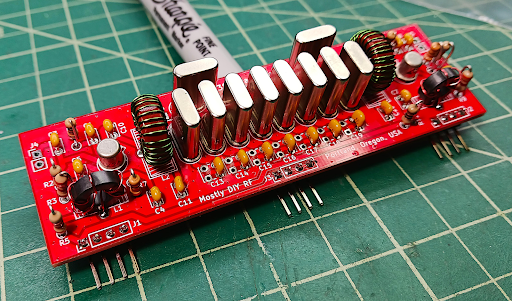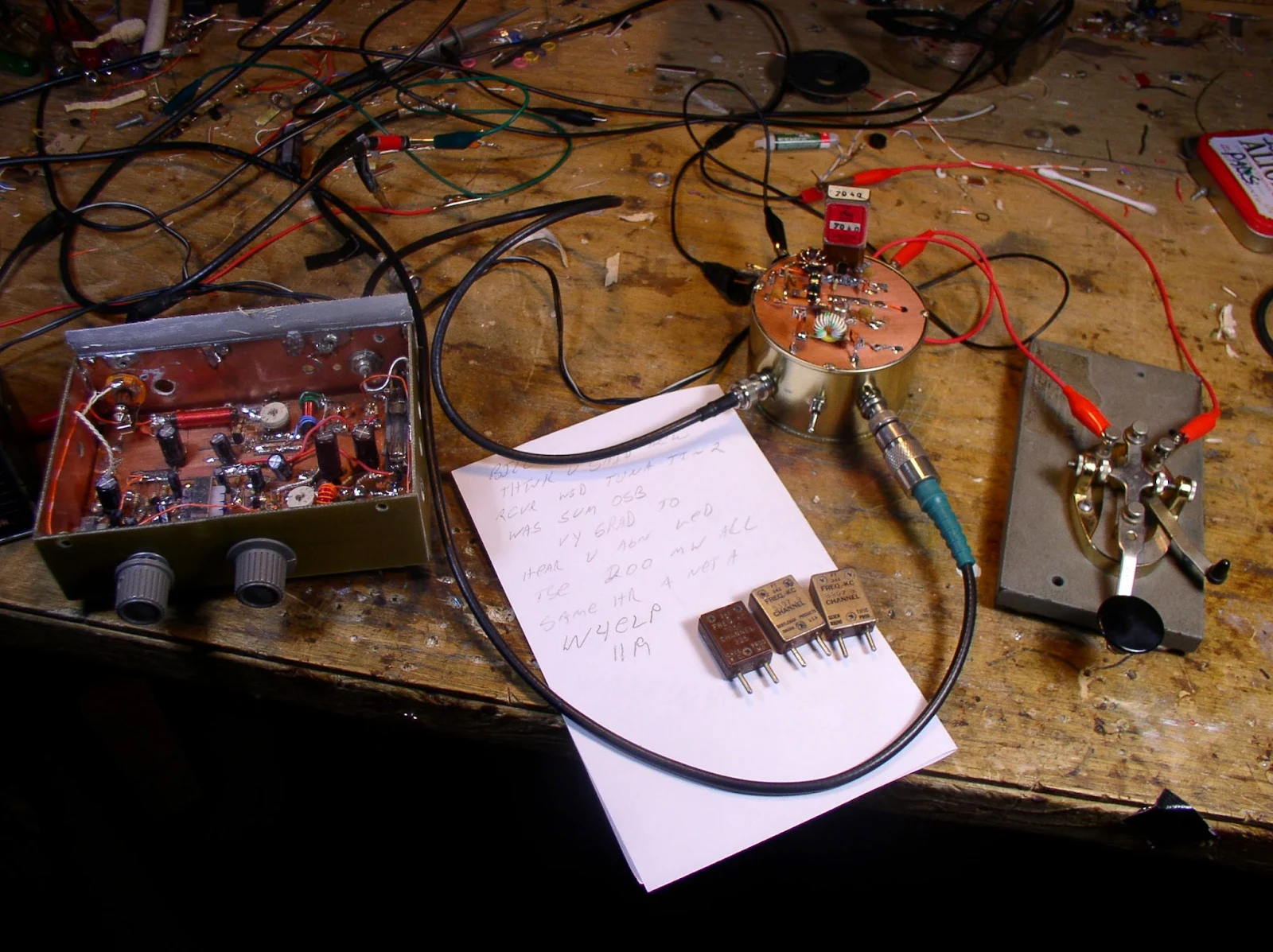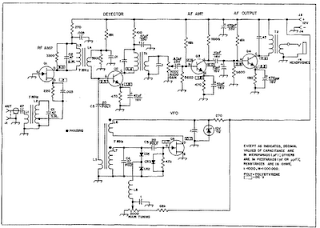Serving the worldwide community of radio-electronic homebrewers. Providing blog support to the SolderSmoke podcast: http://soldersmoke.com
Podcasting since 2005! Listen to Latest SolderSmoke
Monday, October 23, 2023
Bringing a Faulty Herring Aid 5 Receiver Into the Light -- Fixing the AF Amp Schematic Error (video)
Thursday, October 19, 2023
How a Homebrewer Substituted MPF102s for the RS 2035 FETs in the Herring Aid 5 -- Who built this one? Any others out there?
For background on all this, see yesterday's blog post: https://soldersmoke.blogspot.com/2023/10/a-big-error-discovered-in-1976-qst.html
Rick WD5L noted that it was remarkable how the builder of the Herring Aid 5 that I found early in 2023 at a hamfest had built his receiver using MPF102s at Q1 and Q5. Here is how this builder kind of "shoe horned" MPF 102s into the QST Herring Aid 5 boards. Pinouts for the MPF102 and the RS 2035 and the PC Board Pattern for the Herring Aid 5 appear below.
Sunday, February 6, 2022
FLASHBACK: The Herring Aid 5 Direct Conversion Receiver and Frank Jones (Video)
Friday, November 10, 2023
SolderSmoke Podcast #249 -- Travel, Pete's 6BA6 rig, Books!, VFOs, SDR, Computers, Spectrum Analysers, Transistor Man! MAILBAG
Bill's DXCC-100. DONE.
Tribal Wisdom: W1REX on HRWB https://soldersmoke.blogspot.com/2023/11/listen-to-rex-w1rex-lots-of-tribal.html
Pete's Bench:
Pete's 6BA6 rig
Pete Re-invents the Shirt-pocket SSB Rig
BEZOS BUCKS ARE BACK! PLEASE BUY THERE! >>>>>>>>>>>>>>>>>>>>>>>
Mostly DIY RF: Work proceeds in the Oregon Silicon Forest on P3ST kit development. Todd is confident the P3ST will be released on December 18th.Many other kits available now: https://mostlydiyrf.com/
Sign up for the newsletter: https://mostlydiyrf.com/subscribe/
Rebuild of the 15-10 VFO (for improved Dial Spread) (with yet another QF-1 capacitor) https://soldersmoke.blogspot.com/2023/10/dial-scale-linearity-spreading-out.html
Why Building for 10 meters is harder: https://soldersmoke.blogspot.com/2023/09/why-building-for-10-meters-is-harder.html
Copper Tape shielding of 15-10 rig.
Crushing Spurs with Better Bandpass Filters (see blog post) https://soldersmoke.blogspot.com/2023/09/crushing-17-and-12-meter-spurs-with.html
Another 15-10 rig in the works... for SSSS. Boards are accumulating...
More problems discovered with the Herring Aid 5 Receiver . Lots of SS blog posts Comment from Rick WD5L. ) https://soldersmoke.blogspot.com/2023/10/a-big-error-discovered-in-1976-qst.html Did you try to build one? Did you succeed or did you fail? Please let us know.
The Basil Mahon books (blog posts) https://soldersmoke.blogspot.com/2023/11/basil-mahon-is-author-for-us-he.html
The Sunburst and Luminary book of Don Eyles (blog posts)
The Art of Electronics by Horowitz and Hill (blog posts)
Spectrum Analysers: Tiny SA Ultra https://soldersmoke.blogspot.com/2023/09/the-tinysa-ultra-spectrum-analyser-video.html and Polarad 632C-1; George WB5OYP gave me one of these spectrum analysers (I NEED a manual! Does anyone have a manual or a schematic? ) :
Stabilizing the EB63A (with Pete recommended LP filters from e-Bay.
MAILBAG:
TRANSISTOR MAN T-SHIRTS! Thanks to Roy WN3F!
Todd VE7BPO on AF amplifiers. Thanks Todd.
Wes W7ZOI -- Always a privilege to exchange e-mail with Wes.
E-mail from Jay Rusgrove W1VD. About the Herring Aid 5.
E-mail from Eamon Skelton EI9GQ! Amazing!
HB2HB with Denny VU2DGR https://soldersmoke.blogspot.com/2023/09/hb2hb-contact-with-denny-vu2dgr.html
Nick M0NTV on diode matching for ring mixers: https://soldersmoke.blogspot.com/2023/10/does-matching-matter-diode-matching-for.html
Paul Taylor VK3HN on the new Elecraft CW rig.
Dean KK4DAS fixed the noise in his Hallicrafters SW receiver. A long battle, finally won.
Dean also in contact with G3UUR.
Ramakrishnan VU2JXN helping me set up a backup of blog on WordPress.
Mark KA9OOI noticed that SS podcast archive appears gone. In fact just temporarily relocated to http://soldersmoke.com/
(SS PODCAST Archive temporarily relocated to http://soldersmoke.com/
Andreas DL1AJG - Crystal radio video. https://soldersmoke.blogspot.com/2023/10/building-crystal-set-videos.html
George N2APB on the Herring Aid 5
Grayson KJ7UM experimenting with Varactors and Thermatrons!
Thomas K4SWL on Mattia's DC receiver. https://soldersmoke.blogspot.com/2023/10/mattia-zamanas-amazing-direct.html
Bob Weaver of Dial Bandspread Linearity fame. Electron Bunker
Mike Bryce WB8VGE QRP Hall of famer -- he too couldn't get the Herring Aid 5 working.
Kirk NT0Z wrote about the Wayback machine. But this former ARRL staffer he also tried and failed to get the Herring Aid 5 going. Way back when... https://soldersmoke.blogspot.com/2015/03/kirks-herring-aid-tuna-tin-and-regen.html
Sunday, March 9, 2014
I Too Built a Tuna Tin 2
I didn't plan on doing this. I didn't even really want to do this. I've become a phone guy -- I'm not into CW anymore. I figured I'd just finish the Herring Aid 5 receiver and settle the score from 1976 and that would be it. But everything I read about the Herring Aid 5 included references to the iconic Tuna Tin 2. Obviously I was also under the strong influence of my late February encounter with the original TT2 at the Vienna Wireless Winterfest. That Mojo is powerful stuff! Then my wife brought home this can of Russian tuna. The dimensions were perfect. Then I looked in my junkbox and found 40 meter CW crystals. That was it. I had to do it.
I built mine Manhattan style, using several of W1REX's fantastic Me-pads. I also used as the final a transistor that Rex gave me at Winterfest. Thanks Rex. Soul in the New Machine.
I'm getting about 200 mW out. I;m on 7030 kHz and 7040 kHz and 7110 kHz. I have the TT2 up with my Drake 2-B (Herring Aid 5 integration will come later). I can feel the Mojo.
I just had my first contact with the TT2: I called CQ on 7110 and AB2RA came back. Jan was running 20 watts from an old 807 rig, listening with an old Hammarlund. So it was HB transmitter and vintage receivers on both ends! FB!
Our book: "SolderSmoke -- Global Adventures in Wireless Electronics" http://soldersmoke.com/book.htm Our coffee mugs, T-Shirts, bumper stickers: http://www.cafepress.com/SolderSmoke Our Book Store: http://astore.amazon.com/contracross-20
Monday, March 31, 2014
SolderSmoke Podcast #159: Hamfests, Herring Aids, and Tuna Tins
April 1, 2014
Vienna Wireless Hamfest
BITX Talk
W1REX speaks
Tuna Tin 2 Mojo Transfer Ceremony
After 38 years -- finishing my Herring Aid 5 receiver
Feedback, Phasing Dots, Rotational Sense, and Oscillation (or not)
Motorboating (when you don't want to)
Building my Tuna Tin 2 with parts from W1REX
On the air with Tuna Tin and Herring Aid
More Minimalist Meanderings:
An (Almost) All Altoid Crystal Radio!
Tek 465 dies (again) :-(
MAILBAG
Our book: "SolderSmoke -- Global Adventures in Wireless Electronics" http://soldersmoke.com/book.htm Our coffee mugs, T-Shirts, bumper stickers: http://www.cafepress.com/SolderSmoke Our Book Store: http://astore.amazon.com/contracross-20
Saturday, March 1, 2014
38 Year HB Mystery Solved? Was it the phasing dots?
During the summer of 1976, at the age of 18, I made an audacious attempt to join the ranks of the true homebrewers. I tried to build a receiver. It was the Herring Aid 5 from the July 1976 issue of QST, a 40 meter Direct Conversion receiver intended for use with the famed Tuna Tin 2. As I have recounted (perhaps ad nauseum), I never got it to work. My recent encounter with the ORIGINAL Tuna Tin 2 (Mojo was transferred to my BITX17, and it definitely works better now) got me thinking about this painful experience. I decided to try again.
There is an updated NORCAL schematic for this rig. I found it (and some good articles) on the NJQRP club page. In the original, designer Jay Rusgrove, WA1LNQ, used only parts that could be found at Radio Shack stores. In the days before the internet and Mouser, this was a good idea. Instead of toroidal ferrite and iron powder coils, Jay built his coils around Radio Shack solonoidal 10 uH chokes.
The NORCAL version dispensed with the Radio Shack chokes, and used toroids. But I wanted to try to find out what went wrong 38 years ago. So I dug up some 10uH chokes.
I know that my problem was that I never got the oscillator working. I remember being able to hear signals with my "almost" receiver when I put my HT-37 in "CAL" mode and tuned through 40. I was so close! The Herring Aid was picking up RF from the HT-37 and using that in lieu of the LO energy that obviously wasn't coming from my Herring Aid VFO. But WHY didn't that oscillator work?
Today I started with the VFO. Again, it didn't work! But now I have decades of troubleshooting experience under my belt. So I poked around a bit. Then I decided to look closely at the phasing.
Take a look at the schematic(above) and the picture (below). L7 is the 10uH choke. L6 is 4 turns wound over it (or adjacent to it). Now, here is the key question: Look at the phasing dots. How would you guys connect those coils? For me, the schematic indicates that the TOP of L6 should go to the Zener and the BOTTOM of L6 should go to the drain of the JFET. The TOP of the choke should go over to C5, and BOTTOM of L6 should go to ground. Right? Or am I reading the phasing dots wrong?
Well, the oscillator was not oscillating in this configuration. Then I did something that I might not have known to try back in 1976: I reversed the phase of L6: I put the top of the coil to the Drain of the JFET and the bottom of the coil to the Zener. Bingo. The joy of oscillation. Now it works. (The picture below shows it as it is when the oscillator is working well.)
So, is there an error in that diagram? Was this not all my fault?
Aha! I just looked at the schematic of the NORCAL version. Check out the dots! I think that was the problem!
Our book: "SolderSmoke -- Global Adventures in Wireless Electronics" http://soldersmoke.com/book.htm Our coffee mugs, T-Shirts, bumper stickers: http://www.cafepress.com/SolderSmoke Our Book Store: http://astore.amazon.com/contracross-20
Tuesday, March 4, 2014
Herring Aid: It was NOT the dots! Rotational Sense and Phasing
My second attempt at building a Herring Aid 5 (the first was 1976) continues.
I thought I had discovered an error in the schematic that (I hoped) explained my failure to get this simple receiver running (scroll down for details). But Dex, ZL2DEX, in New Zealand spotted something that got QST off the hook and put all the blame back on me:
I had failed to check the rotational sense of the windings. The schematic called for 4 turns over the Radio Shack choke. So I just went ahead and wound them. I didn't pay any attention to the direction of the winding. I then hooked it up in accordance with the phasing dots in the diagram. And it didn't work. So I switched the coil connections around. And it worked. Aha! I thought! QST messed up! It wasn't my fault.
Dex brought me back to reality. He noted that I probably wound the coils with the wrong rotational sense. I confirmed this. I rewound the coil following the rotational sense of the choke. I hooked it up following the phasing dots of the schematic. This time the oscillator started right up. So the problem wasn't an incorrect drawing of the phasing dots. Instead it was my failure to remember that phasing is more than just the top or the bottom of a transformer's winding. Rotational sense is also important. That's why "phasing dots" are sometimes referred to as "sense dots."
This doesn't come up very often, because most of the toroidal transformers we make are bifilar or trifilar -- the windings are always in the correct sense because we twist the wires together before putting them on the coil. When we look at those phasing dots, we are focused on getting the proper tops of coils connected to the appropriate bottoms of other windings. We don't pay any attention to the sense of the windings. Thanks to Dex for bringing me back to my senses :-o
Grob's Basic Electronics has this definition for those phasing dots:
| " | Used on transformer windings to identify those leads having the same instantaneous polarity." |
This morning I did a little experiment to confirm all this: I took a toroidal core and wound a little transformer. Using a dual trace scope, I looked at the input and output wave forms. Sure enough, when the windings are in the same rotational sense, there is no phase shift. But when that secondary is wound in the opposite sense, you get a 180 degree phase shift. I know this is very basic, but it was fun to re-learn it and to confirm is.
But I still don't have the little receiver running. I think there are a few problems. That single BJT mixer stage needs a lot of RF (2.5 volts p-p) from the oscillator. Also, I think the 10 uH chokes that I am using are not the same as the chokes used in the original Herring Aid design. So when I build transformers on these chokes, they don't work very well.
But I will keep at it. It has been 38 years... I can wait another week or two.
Our book: "SolderSmoke -- Global Adventures in Wireless Electronics" http://soldersmoke.com/book.htm Our coffee mugs, T-Shirts, bumper stickers: http://www.cafepress.com/SolderSmoke Our Book Store: http://astore.amazon.com/contracross-20
Wednesday, October 18, 2023
A Big Error Discovered in the 1976 QST "Herring Aid 5" Article (After 47 Years)

Sunday, March 30, 2014
First Contact with Herring Aid 5 AND Tuna Tin 2
Our book: "SolderSmoke -- Global Adventures in Wireless Electronics" http://soldersmoke.com/book.htm Our coffee mugs, T-Shirts, bumper stickers: http://www.cafepress.com/SolderSmoke Our Book Store: http://astore.amazon.com/contracross-20
Wednesday, September 20, 2017
Can You See an Error in the Herring Aid Five Schematics?
Saturday, April 1, 2023
SolderSmoke Podcast #245: Cuban DSB, DC Receiver?, Can you spot the AI? (Prize), Winterfest Loot, Gina's Podcast, 6BA6 buy, MAILBAG
Travelogue: Cuba DSB and AM. Jose CO6EC and the Islander. We need more info, especially on the solid state Jaguey rig.
Bill’s bench:
Will the High School DC receivers get finished? Future uncertain. But the project was technically interesting. Great working with Dean KK4DAS. Battling AM breakthrough from Radio Marti. We joked that Dean has been listening to Radio Marti so much that even though he doesn’t speak Spanish, he has noticed an increased urge to liberate Havana.
Audio amps: Harder than we thought. Lots of variation in Hfe of 2n3904s. Oscillations.
Not using feedback amps nor LM386s, nor push-pull. Simplicity is a design goal.
Fixing the tuning (bandspread) problem on the VFO was fun.
Antennas? A quarter wave with ground or counterpoise works well. We tried it. (59) An Antenna for the TJ 40 Direct Conversion Receiver - YouTube
----
Back to work on the uBITX. I chickened out on replacing the predriver with a BFR-106, but then – Just in time Todd K7TFC and his Mostly DIYRF came out with BFR106 boards! TRGHS. I will do the mods on two uBITX transceivers. I even bought a solder-sucking iron for the second job.
Winterfest Hamfest. Big success. Thanks VWS. HERRING AID FIVE! Simpson 260! QF-1, Another Radio Shack DMM, Eamon Skelton’s Homebrew Cookbook, Knobs, SWR meter.
----
----Interview on his Pete's daughter’s podcast. https://soldersmoke.blogspot.com/2023/03/listen-to-pete-juliano-on-his-daughter.html
-- 6BA6 e-bay buy. Will we see an all 6BA6 rig from Pete?
-- The NCX-5 on e-bay
PETE’S NEW BLOG: https://hamradiogenius.blogspot.com/
Mailbag:
-- A New SPRAT arrived in the mail. PH2LB’s Gluestick on the cover.
-- Will KI4POV – Awesome homebrew – on the blog.
-- Sands, VK9WX listening to SolderSmoke on Willis Island! Wow.
-- Andreas DL1AJG in Germany continues with the Electronics for Biologists DC RX build.
-- Dean KK4DAS and his homebrew 10 meter DSB rig.
-- Jim W2UO built a Michigan Mighty Mite and made a contact.
-- Dave K8WPE and the E in IBEW. We need new stickers.
-- Bob KC4LB – Surface Mount is SMALL.
-- Bruce KK0S on the Herring Aid 5 Board.
-- Chuck WB9KZY on Nuclear Monopole Resonance very cool video – on the blog.
-- Alan WA9IRS wants a CW editor for his phone. Really.
-- Vic WA4THR also working on uBITX power out improvement.
-- Tobias weighs in on Kludge. As in Fudge.
-- Tony G4WIF notes that when he changes his oil he often removes sludge, not slooge.
-- Consultations with Lexicographer Steve KB3SII.
-- Walt AJ6T says CW operating declined after FCC ruling in 1970s about callsigns.
-- Ramakrishnan VU3RDD now VU2JXN has joined the VWS. An old friend of SolderSmoke. Urged us to launch a blog back in 2008. We announced his daughter’s birth - - now Ram is getting ready to build a DC receiver with her.
Friday, March 7, 2014
Some notes on the Herring Aid 5
Sure, this receiver is not "state of the art." But that's the whole point. I wanted to finish the receiver project that I couldn't finish back in 1976.
I tried to stick as close as possible to the original design and parts. NORCAL came up with an updated schematic in 1998 with parts that are more readily available. But Designer Jay Rusgrove was shooting for something that could be built with all the parts coming from Radio Shack. I think that is probably one of the factors that attracted me to the project way back when. That's why Jay went with varactor tuning (no hard-to-get variable caps!). And that's why he used coils that were wound on Radio Shack 10uH RF chokes (no need for hard-to-find toroidal cores). In this sense there is some common ground between the BITX rigs and the Herring Aid 5.
I stuck with the RF-choke as a coil idea for the VFO, but went with the NORCAL-prescribed toroids for the front end and mixer coils. (I may go back and try to use chokes in these circuits, but I'm not sure my junk-box will yield the kind of RF chokes that Jay used).
I wish I had known a few things when I was building this back in 1976: More knowledge about how to wind the coils would have been a big help. I wish I had realized that I could use a SW receiver to get the oscillator on the right frequency. I guess this was in the days before Ugly and Manhattan building techniques, but it would have been nice to know that there was no need to actually etch a board for this project (I did!).
The coils really are a bit tricky. Jay didn't use any trimmer caps, so I guess you had to just hope that the front end coil and cap resonated somewhere near 40 meters. As for tuning the oscillator, Jay recommended scrunching and un-scrunching the turns on the RF choke. Yikes! Give me some trimmer caps!
I also found that you have to watch the level of the RF going from the oscillator to the mixer. Too much, and the receiver is deaf. Too little, same result. You need to experiment a bit with the number of turns on the pick-up coil from the oscillator.
The warnings about the pitfalls of that single BJT mixer were right on the mark: Lots of AM SW breakthrough. But I kind of like the background music. Strong RFI from local FM broadcast stations was another story (WMZQ is a country music station!). I reached into my junkbox and found a low-pass filter from a Heathkit DX-60. I just put that between the antenna and the receiver and the country music was GONE!
I really love this little receiver. I have it playing 40 meter CW as I type. It sounds great. I feel the urge to built a Tuna Tin 2 and put both of them on 40.
In the original Tuna Tin 2 article, Doug DeMaw notes that Jay Rusgrove was thinking of doing a companion receiver and says that he was thinking of calling it the "Clam Can 5" ! There were jokes about receivers for hams with "tin ears" and about there being "something fishy" about these rigs.
Thanks to Doug DeMaw and Jay Rusgrove and QST for bringing us these little circuits.
Our book: "SolderSmoke -- Global Adventures in Wireless Electronics" http://soldersmoke.com/book.htm Our coffee mugs, T-Shirts, bumper stickers: http://www.cafepress.com/SolderSmoke Our Book Store: http://astore.amazon.com/contracross-20
Monday, July 22, 2019
Making Fish Soup from Herring and Tuna (How to Build a Fish Soup 10 Transceiver)
Sunday, June 18, 2017
A Fishy Rig: Herring Aid Five, Tuna Tin Two, VU2XVR Key
Saturday, June 16, 2012
Long Lost Varactor Receiver Found!
Thursday, September 21, 2017
Herring Aid Error: C14
Yea, take a look at C14 in the AF amp. At 1000 Hz 10uF is about 16 ohms. That would put a serious dent in the AF gain. And indeed, when I went back to my Herring Aid 5 (38 years from start to finish) and pulled C14 out, there was a dramatic increase in AF gain.
Mistakes happen, but I wonder if anyone else spotted and reported this one. Could someone with access to the QST archives check to see if an Erratum was ever published? The project also appears in the 1977 ARRL book "Understanding Amateur Radio" with the problematic C14. My guess is that it was just an error in the value of the cap.
Sunday, July 7, 2019
The Fish Soup 7 QRP Rig -- On the Air on 40 Meters (video)
I don't know why, but this weekend I got the urge to get on the air with a very low power homebrew QRP rig. I reached for my Tuna Tin 2 -- Herring Aid 5 combo. I call it the Fish Soup 7 (seven transistors in total).
I first tried to turn this rig into a transceiver by taking the VFO signal from the receiver (it is direct conversion) and using it to excite the Tuna Tin 2, but it just didn't work out. The oscillator in the Herring Air 5 is very bare bones -- no buffering and an LC circuit that is mostly L (10 uH). It became very difficult to get a stable amount of CW offset. So I went back to crystal control for the transmitter. I did replace the 5K tuning pot in the RX with a 10k 10 turn pot (thanks to W8NSA). Tuning is now very smooth. I used my old UK freq counter to monitor my receive freq. (Thanks to Tony Fishpool G4WIF-- back in 2009 he sent me the CMOS chip that brought this counter back to life.)
I was putting out about 750 milliwatts.
I had a very quick contest-like contact with K2D -- one of the "13 Colony" stations. Then a longer chat with Hank K1PUG (see video above).
I had lost my 7050 crystal, but this morning it re-appeared. TRGHS.
As you can see in the video I am using the beautiful VU3XVR key that Farhan brought me from India.
This was fun. I may try to put a VFO of some sort into the TT2, just to get more agility. But I want to keep things simple.
Look for me on 7050.
Saturday, March 21, 2015
Kirk's Herring Aid, Tuna Tin, and Regen Adventures
I'll be listening. :)
73,
--Kirk Kleinschmidt, NT0Z
Rochester, MN
Editor, 1990 ARRL Handbook
Technical Editor, Ham Radio for Dummies
QST Assistant Managing Editor, 1988-1994
Ham Radio Columnist since 1989 for:
Popular Communications
Monitoring Times and now,
The Spectrum Monitor (www.thespectrummonitor.com)
www.stealthamateur.com and on the Amazon Kindle (soon)
Our book: "SolderSmoke -- Global Adventures in Wireless Electronics" http://soldersmoke.com/book.htm Our coffee mugs, T-Shirts, bumper stickers: http://www.cafepress.com/SolderSmoke Our Book Store: http://astore.amazon.com/contracross-20















.jpg)

















.jpg)







